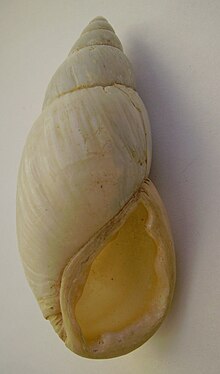Placostylus ambagiosus
| Placostylus ambagiosus | |
|---|---|

| |
| A shell of the subspecies Placostylus ambagiosus priscus | |
| Scientific classification | |
| Domain: | Eukaryota |
| Kingdom: | Animalia |
| Phylum: | Mollusca |
| Class: | Gastropoda |
| Subclass: | Heterobranchia |
| Order: | Stylommatophora |
| Family: | Bothriembryontidae |
| Genus: | Placostylus |
| Species: | P. ambagiosus
|
| Binomial name | |
| Placostylus ambagiosus | |
Placostylus ambagiosus is a
Description
This snail has a large (43–97 millimetres or 1.7–3.8 inches long)[5] shell, which is heavily calcified. The size of the adult shell is habitat dependent,[5] but the shell shape is not plastic.[4] Placostylus ambagiosus is highly valued by Te Aupōuri me Ngāti Kurī (the indigenous people of northern New Zealand) as a food source, musical instrument and in the past this snail provided alarm calls at night warning of approaching invaders.[6]
Distribution
This land snail species occurs in
Biology
This snail feeds at night on fallen leaves on the forest floor.[5] A favorite plant species is hangehange (Geniostoma ligustrifolium). Placostylus ambagiosus needs year round moisture provided by deep leaf-litter. Eggs are laid in clutches (average 43 eggs) in the shallow hollows in the soil.[5] The species is slow-growing with a lifespan of 10–22 years and strong site fidelity[12] The same individual snail has been found under the same food plant for 12 years.[5] The species is endangered due to predation from rats[13] and birds,[14] habitat damage by pigs and horses and competition from introduced snails.[13]
Hypothetical subspecies
Based on
- Placostylus ambagiosus "Herangi Hill" †
- Placostylus ambagiosus "nouvelle" - nationally endangered
- Placostylus ambagiosus "Haupatoto" - nationally critical
- Placostylus ambagiosus "Kauaetewhakapeke Stream" - nationally critical
- Placostylus ambagiosus "Kohuronaki" - nationally critical
- Placostylus ambagiosus "Poroiki" - nationally critical
- Placostylus ambagiosus "Te Paki" - nationally endangered
- Placostylus ambagiosus "Tirikawa" - nationally critical
- Placostylus ambagiosus ambagiosus Suter, 1906 - nationally critical
- Placostylus ambagiosus annectens Powell, 1938 2
- Placostylus ambagiosus consobrinus Powell, 1938 - nationally critical
- Placostylus ambagiosus gardneri †
- Placostylus ambagiosus hancoxi 1
- Placostylus ambagiosus hinemoa †
- Placostylus ambagiosus keenorum Powell, 1938 - nationally endangered
- Placostylus ambagiosus lesleyae †
- Placostylus ambagiosus michiei Powell, 1951 - nationally endangered
- Placostylus ambagiosus pandora Powell, 1951 - nationally critical
- Placostylus ambagiosus paraspiritus Powell, 1951 - nationally endangered
- Placostylus ambagiosus priscus †
- Placostylus ambagiosus spiritus †
- Placostylus ambagiosus watti Powell, 1947 - nationally critical
- Placostylus ambagiosus whareana Powell, 1951 - nationally critical
- Placostylus ambagiosus worthyi †
References
- . Retrieved 20 November 2021.
- ^ Suter H. (1906). J. de Conch. 54: 253, plate 8, figure 1-3.
- Museum of New Zealand Te Papa Tongarewa. Retrieved February 5, 2010.
- ^ .
- ^ S2CID 85060133.
- ^ Taonga, New Zealand Ministry for Culture and Heritage Te Manatu. "2. – Snails and slugs – Te Ara Encyclopedia of New Zealand". teara.govt.nz. Retrieved 2019-08-16.
- ^ ISBN 978-0-478-14288-4.
- Wikidata Q58676647.
- Wikidata Q58676724.
- JSTOR 20707255.
- PMID 19323188.
- S2CID 89729069.
- ^ S2CID 86580704.
- ISSN 0006-3207.
- ^ .
- ^ "Extinct Species of New Zealand". Natural Heritage Collection. Retrieved February 5, 2010.
- ^ "Terrestrial invertebrate - part one". New Zealand Threat Classification System. Department of Conservation. 2002.
Further reading
- ISBN 0-00-216906-1.
- Suter H. (1913). Manual of the New Zealand Mollusca. Wellington, 1120 pp., page 768.

